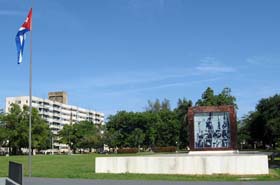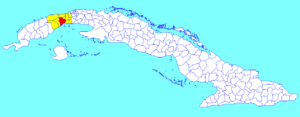Artemisa facts for kids
Quick facts for kids
Artemisa
|
|||
|---|---|---|---|

The Martyrs Mausoleum (Mausoleo de los Mártires)
|
|||
|
|||

Artemisa municipality (red) within
Artemisa Province (yellow) and Cuba |
|||
| Country | Cuba | ||
| Province | Artemisa | ||
| Founded | 1818 | ||
| Incorporated | 1976 | ||
| Founded by | Francisco de Arango y Parreño | ||
| Area | |||
| • Municipality | 690 km2 (270 sq mi) | ||
| Elevation | 50 m (160 ft) | ||
| Population
(2022)
|
|||
| • Municipality | 86,444 | ||
| • Density | 125.3/km2 (324.5/sq mi) | ||
| • Urban | 60,765 | ||
| Demonym(s) | Artemiseño, -a | ||
| Time zone | UTC-5 (EST) | ||
| Area code(s) | +53-47 | ||
| Climate | Aw | ||
Artemisa (Spanish pronunciation: [aɾteˈmisa]) is a city and a municipality in Cuba. It used to be part of La Habana Province.
In August 2010, a new law made Artemisa the capital city of the new Artemisa Province. This new province includes eight municipalities from the old La Habana Province and three from Pinar del Río. Artemisa covers about 642 square kilometers. In 2022, it had over 86,444 people living there.
Artemisa is known as the "Jardín de Cuba" (Garden of Cuba). This is because it used to have many coffee farms and beautiful countryside. It is also called the "Villa Roja" (Red Village) because of its red soil.
The city is home to the University of Artemisa. This university trains experts in farming, teachers, and business professionals. There is also the Faculty of Medical Sciences of Artemisa. It trains doctors, dentists, and other health workers.
Contents
History of Artemisa
Artemisa was founded in 1818. It started after a big fire in Havana on April 25, 1802. This fire left many families without homes. So, officials decided to create new towns outside the city.
In 1818, Francisco de Arango y Peñalver donated land. This allowed the building of the church to begin. The church opened on December 22, 1825. The exact meaning of the name Artemisa is not fully known. Some think it comes from the Greek goddess Artemis. Others believe it refers to a plant called Artemisia (ragweed), which was common there.
The municipality of Artemisa was officially created on June 9, 1878. The first meeting of its City Council happened on January 1, 1879.
Artemisa did not take part in the first War of Liberation (1868–78). This war did not reach the western part of Cuba. However, Artemisa played a role in the 1895 war. More than 200 local people joined the Mambi forces. These were Cuban fighters for independence. Important figures from Artemisa include Manuel Valdés, Colonel Federico Nuñez, and General Alberto Nodarse Bacallao. Even the local priest, Guillermo González Arocha, helped.
During this time, Captain General Valeriano Weyler used a policy called "Reconcentration." This forced people from the countryside to move into towns. This was to stop them from helping the Cuban fighters.
Artemisa was also important during Fidel Castro's Cuban Revolution. Many fighters from Artemisa supported the attack on "Cuartel Moncada" in 1953. They also joined the Sierra Maestra Guerrilla (1956–1959). Ramiro Valdés Menéndez, a high-ranking Cuban official, was born in Artemisa. He fought alongside Che Guevara. Other important people from Artemisa in the Revolution were Eduardo García Lavandero and Carlos Rodríguez Careaga. The Martyrs Mausoleum (Mausoleo de los Mártires) in Artemisa is a National Monument of Cuba.
Artemisa was part of Pinar del Río Province until 1970.
Geography of Artemisa
The Artemisa municipality is in the middle of Artemisa Province. To the north, it borders Mariel and Guanajay. To the east, it borders Caimito and Alquízar. To the south, it meets the Ensenada de Majana. To the west, it borders Candelaria.
The municipality has several local areas called consejos populares. These include Cayajabo, Centro, Corojal, La Matilde, Las Cañas, Lavandero, Lincoln, Reparto Nuevo, and Todelo.
People of Artemisa
In 2022, the municipality of Artemisa had a population of 81,209 people. The total area is about 690 square kilometers. This means there are about 130 people per square kilometer.
Artemisa's Economy
In the 1800s, Artemisa grew rich. This was thanks to coffee, then tobacco, and later sugar.
Artemisa once had about 47 coffee farms. The most famous was "Angerona." It was one of the biggest coffee farms in Cuba. Other farms like El Pilar and Andorra closed in the early 2000s. The sugar industry is no longer as important in Artemisa.
The economy grew even more when the railway arrived in 1864. Later, the Central Highway of Cuba was built. These helped Artemisa become an important stop between Pinar del Río and Havana.
Today, Artemisa's economy relies on several things. These include farming (fruits, various crops, rice, sugar cane) and pig farming. It also has cement factories and other building material industries. Tobacco and textile manufacturing are also important. The making of pesticides is another part of the economy.
Main Sights to See
One historical place is the Cafetal Angerona. This coffee farm is now in ruins. It was named after Angerona, a goddess of silence and fertility. The ruins remind us of a time of wealth and business. The farm belonged to Cornelio Souchay, a German businessman. He fell in love with Úrsula Lambert, a black Haitian woman. They kept their love a secret because of the rules of that time.
The Hotel Campoamor was built in 1911 by Fernando González-Campoamor. Many famous people have stayed there. These include Rita Longa, Ernest Hemingway, Juan Marinello, Gabriela Mistral, and Ignacio Villa "Bola de Nieve." The old sugar mills, Pilar and Lavandero, are also important landmarks. So is the mansion of sugar boss, Julio Lobo.
Artemisa's patron saint is Saint Mark the Evangelist. The church of Artemisa is in The Park (el Parque). The church building was fixed up thanks to Father Antonio Rodriguez Dias. Many people from Artemisa helped, and German friends gave money.
Another interesting place is the Artemisa Municipal Museum.
Famous People from Artemisa
Many important people in Cuban history were born or lived in Artemisa. Magdalena Peñaredonda was a poet and journalist. She became a captain in the rebel forces during the war for independence. Father Guillermo González Arocha was born in Regla. But he did much for Cuba's independence while being a priest in Artemisa. He is seen as an adopted son of the city. This priest also started a school and had the city's cemetery built.
The famous trumpet player Arturo Sandoval was also from Artemisa. He moved to the U.S. in 1990.
See also
 In Spanish: Artemisa (Cuba) para niños
In Spanish: Artemisa (Cuba) para niños



